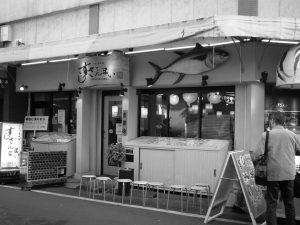
The largest attraction of Tsukiji are fish, the sushi. And how can we gather people just around sushi? It had to be eye-catching and also sufficient to satisfy the customers. Only then, could we save Tsukiji from this situation. I decided on a shop resolving all issues that sushi restaurants encounter, therefore the idea was to keep the shop open 24 hours a day all year round.
Non-conveyor-style sushi shops were previously never open on days the markets were closed. Even places that were open, had to close early due to running out of ingredients. These were all due to the shops management. Just because customers wanted to eat good sushi, that didn’t necessarily mean the shops would be open at all times. That was why I decided on opening a shop that could offer sushi at all hours on any day of the week to the customers that wanted to eat good sushi at any time. But just being open was not enough. Just because the shop was open, that would not satisfy the customers if our selection of sushi was limited. That is why there were more than 150 items on the menu for only one type of ingredient.
Since I had almost 30 years of experience in the fishing industry, I had no issues sourcing many types of sushi ingredients through my own network. Not only from the location of the catch through wholesalers and finally to the shop, I had also created a system of distribution directly connecting the production location with the shops. I invested time to visit the catch location, carefully made the selection and sold everything on my own responsibility. This was included in my fundamental tasks ever since I had joined the fishing industry. Due to the network that I had built through the years, I was able to procure fresh seafood for sushi from various domestic and foreign production regions.
<<New Ideas Adopted to Modify the Shop’s Atmosphere>>
Owing to the success of Kiyozushi, I was also able to incorporate reasonable pricing. I made sure that prices were set and clear. A piece of nigiri sushi started at 98 JPY (excl. tax). Popular items were sold at 128 JPY (excl. tax) and 148 JPY (excl. tax), while premium menus such as fatty tuna amounted to 398 JPY (excl. tax). By consistently offering fresh and tasty sushi at same prices, customers would needn’t worry about the bill, but just enjoy their meals.
I also made sure that the atmosphere of the shop was unlike anything seen before. I set the main corporate color as bright pink, and made sure the front of the store was covered with glass panels to the utmost possible degree, so that those passing by could look inside. There were no shop curtains, instead, I had a tuna model installed to make sure the shop had a casual and welcoming look. In addition, I guided the sushi chefs to be entertaining and to create a light-hearted, fun and full of energy customer experience. The creation of a sushi shop that was welcoming, affordable, and with great service, a place, unseen previously was the ideal I was striving to achieve.
<<In April 2001, Japan’s first sushi restaurant open 24 hours a day all year-round — the SUSHIZANMAI Honten (Main Store) — came to life>>
This sushi shop that opened in Tsukiji’s prime location was as unconventional as it could be. Not only did the buzz help, but the quality and casual nature of the shop attracted the customers. With the help of the hostesses from Ginza, the solution for attracting customers after midnight was found, thus enabling the creation of eager customer lines at all times. In the first month we made 54 million yen, and continued to grow steadily to 64 million the next month, and 88 million the month that followed.
If somebody wanted to eat sushi, they could always go to the SUSHIZANMAI Honten in Tsukiji. Fresh, authentic sushi at reasonable prices in a lively and entertaining atmosphere. Also, the shop was surrounded by stores offering various food ingredients and cookware, and had thus provided an entertaining area for a walk before or after the meal. Gradually, I began to feel that people had started returning to Tsukiji.
(Interviewer: Masatoshi Ono)
Born in 1952, in the town of Sekiyado (present Noda City) in Chiba Prefecture. Graduated from Chuo University, Faculty of Law (Correspondence Course). After completion of middle school, joined the student platoon of the 4th Technical School of Japan Air Self-Defense Force. Retired from service in 1974. Joined a fishery company after working part-time jobs. Branched out on his own in 1979. In 2001, opened SUSHIZANMAI Honten (The Main Store), Japan’s first-ever sushi restaurant open 24 hours a day all year round, in the Tsukiji Outer Market.
